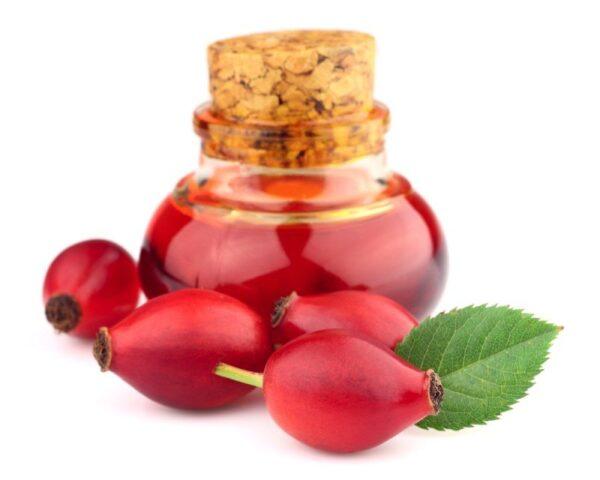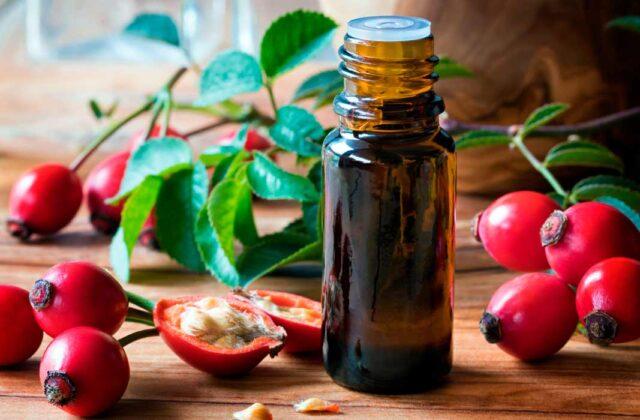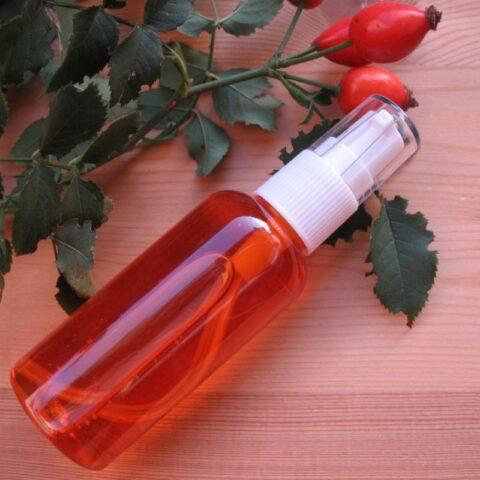Content
- 1 How the composition of rosehip oil is made
- 2 What is useful and what is rosehip oil used for?
- 3 Application in traditional medicine
- 3.1 Rosehip oil for throat, with pharyngitis
- 3.2 Rosehip oil in dentistry, for gums, for stomatitis of the oral cavity
- 3.3 Rosehip oil for the nose for adults, children
- 3.4 How to take rosehip oil for the stomach for gastritis
- 3.5 Rosehip oil for hemorrhoids
- 3.6 Rosehip oil in gynecology
- 3.7 Rosehip oil for burns
- 3.8 With colitis
- 3.9 For immunity
- 3.10 With dermatitis
- 4 Rosehip oil in cosmetology
- 5 The use of rosehip oil for massage
- 6 How to make rosehip oil at home
- 7 Contraindications to the use of rosehip oil
- 8 Conclusion
- 9 Reviews on the use of rosehip oil inside and for hair
The properties and uses of rosehip oil are very diverse. The product is used in cooking and medicine, for skin and hair care. It is interesting to study the features of the tool and its value.
How the composition of rosehip oil is made
Rosehip oil for medicinal and cosmetic use is obtained from the ripe fruits of the plant, or rather, from the seeds. A valuable product is isolated in two ways:
- cold pressing - the seeds are simply squeezed out under tremendous pressure, and then pure oil is extracted by condensation;
- hot extraction - first, the fruits are dried in special machines, and then the pomace is obtained using a natural solvent.
The finished product has a slight bitterness and tangible woody notes in taste and aroma.

The most valuable is the oil obtained by pressing - more nutrients remain in it.
The use of rosehip pomace is due to its rich composition. The product contains:
- organic and fatty acids;
- iron and magnesium;
- manganese, calcium and molybdenum;
- vitamin C;
- vitamins K and F;
- copper and phosphorus;
- beta carotene;
- vitamin A.
There are 284 calories per 100 g of the product. At the same time, nutrients are represented only by fats in a volume of 12.5 g, and there are no proteins and carbohydrates in the composition.
What is useful and what is rosehip oil used for?
The beneficial properties of rosehip oil are mainly used in folk medicine. In particular, the remedy:
- relieves inflammation and restores the integrity of the mucous membranes;
- strengthens the walls of blood vessels and capillaries;
- promotes the production of gastric juice and bile;
- prevents the development of atherosclerosis;
- reduces the level of bad cholesterol;
- has a beneficial effect on the nervous system and helps with depression;
- relieves insomnia;
- has a tonic effect;
- strengthens the immune system and protects against viruses and colds;
- improves vision;
- helps with sinusitis and colds;
- promotes healing of gums with stomatitis and gingivitis.
The use of the product in cosmetology is in great demand. The tool fights the first wrinkles, stops hair loss. It can be used to heal wounds and burns.

Rosehip oil helps to gently disinfect damage
Healing properties of rosehip oil for skin
The use of pomace benefits mostly dry, flaky skin.Rosehip softens the epidermis and restores its nutrition, makes it soft and elastic. The squeeze is used to eliminate cracks, calluses, scars and other defects, the product smoothes the skin well.
The antiseptic properties of the drug help with dermatitis and psoriasis, eczema. the use of the product is indicated for acne, it will not only help cleanse the skin, but also prevent repeated rashes.
Why is rosehip oil useful for children
The product contains substances that can cause allergies or irritation of the stomach mucous membranes. Therefore, rosehip oil for internal use is contraindicated in children under 12 years of age.
However, babies and adolescents are allowed to be treated externally with the product. The squeeze is good for instilling a runny nose into the nose, since it not only frees breathing, but also strengthens the immune system. Its use is indicated for the treatment of skin lesions and rashes in adolescents.
Application in traditional medicine
Homemade health recipes mainly use rosehip pomace to relieve inflammation and colds. There are several popular application algorithms.
Rosehip oil for throat, with pharyngitis
The use of rosehip oil in ENT diseases is especially popular. Vitamin C and other substances with antiseptic properties in the composition help fight inflammatory and bacterial processes. With pharyngitis, cough and sore throat, you can simply lubricate the reddened areas of the mucous membranes with a squeeze. A cotton swab is dipped into a clean product and problem areas are treated pointwise.
Rosehip oil in dentistry, for gums, for stomatitis of the oral cavity
The use of useful pomace relieves inflammation in the oral cavity well. For stomatitis and gingivitis, it is necessary to dilute three drops of the remedy in 200 ml of warm water. After that, rinse the mouth thoroughly with the solution. It is not recommended to swallow the drug, it must be spat out.

It is allowed to rinse with rosehip oil twice a day.
Rosehip oil for the nose for adults, children
The anti-inflammatory and cleansing properties of the product relieve congestion and help fight purulent processes in the sinuses with sinusitis. Rosehip oil can be instilled into the nose - three drops are applied to each nostril. The procedure is allowed up to four times per day.
How to take rosehip oil for the stomach for gastritis
Rosehip oil for oral administration is recommended for gastritis and stomach irritation. But the volumes should be very small. For medicinal purposes, 5 ml of the product is consumed three times a day on an empty stomach, the agent must first be diluted in a glass of warm water. In total, the treatment is continued for ten days, and then they take a break.
Rosehip oil for hemorrhoids
A useful product relieves inflammation, promotes resorption of hemorrhoids and heals cracks. The application scheme looks like this:
- three times a day, 5 ml of the drug diluted in 200 ml of water are consumed;
- make compresses using rosehip oil - a cotton swab is moistened in the preparation and applied to the anus.
The use of applications with a useful product is allowed to be repeated up to four times a day, and inside the squeeze is consumed for up to a month.
Another method suggests mixing 10 ml of the drug with melted wax or pork fat and refrigerate until it hardens. Then, rectal suppositories are made from the resulting funds and inserted into the anus all night.
Rosehip oil in gynecology
The use of rosehip oil is in demand for cervical erosion and infectious diseases.For treatment, applications are used - a cotton swab is moistened in a squeeze and injected into the body for the whole night. It is necessary to continue the procedure until the condition improves, but no longer than a week.
Rosehip oil for burns
The beneficial substances in the composition of the product contribute to the rapid restoration of the epidermis and prevent inflammatory processes in case of tissue damage. With a rosehip-based remedy, healing burns can be treated, in which case there will not even be noticeable scars on the skin. The application is very simple, a cotton pad is moistened in the squeeze and the affected area is wiped or a mini-compress is applied.

It takes about half an hour to keep a compress with rosehip oil for burns.
With colitis
The use of rosehip oil is indicated for ulcerative colitis and pain in the intestines. For medicinal purposes, enemas are used, and they are done like this:
- cleanse the rectum with an infusion of medicinal chamomile;
- fill the syringe with a catheter with 50 ml of rosehip pomace;
- the agent is injected into the anus.
After the enema, you must calmly lie on your left side for half an hour. With an exacerbation of colitis, the procedure is carried out daily for a month, with a calm course of the disease - every other day for the same period.
For immunity
The vitamins in the rosehip pomace strengthen the immune system and increase resistance to colds. In the autumn-winter period, it is recommended to use the drug as a preventive measure. Instructions for using rosehip oil inside looks like this - the drug is drunk at 10 ml per glass of water twice a day, in the morning and in the evening, preferably on an empty stomach.
With dermatitis
The valuable properties of rosehip oil help with dermatitis, eczema and psoriasis. Treatment is carried out with compresses. A gauze napkin should be moistened abundantly in the preparation and fixed on the affected area with a bandage. The procedure is repeated up to three times a day.
External use of the product for dermatitis is useful to combine with internal use. The drug is taken twice a day in a small spoonful, traditionally diluting the drug in a glass of water. In total, therapy must be continued for two months.
Rosehip oil in cosmetology
Rosehip oil is widely used in cosmetics. It is used for rejuvenation purposes, for hair treatment and skin softening, for good eyebrow and eyelash growth.
How to use rosehip oil for hair
The emollient properties of rosehip oil are used to treat dry and weakened hair. The easiest way to use it is to rub a small amount of the product into the roots of the curls and along the entire length, and then leave it for half an hour under a towel. After that, the hair must be rinsed with a mild shampoo and dried without using a hair dryer.

Rosehip oil helps eliminate dandruff caused by dry scalp
A therapeutic mask also brings benefits, which is made according to this recipe:
- 15 ml of oil is mixed with two egg yolks;
- distribute the composition to the curls for half an hour;
- insulate the head with a film and a thick towel;
- after the expiration of the period, the strands are washed.
The use of rosehip oil for hair is carried out at least three times a week. In this case, it will help to quickly restore the strength and beauty of the curls.
Rosehip oil for stretch marks, for chest
With sharp fluctuations in weight, stretch marks often appear on the skin, which are difficult to get rid of. Pregnant women especially often face the problem.
The properties of cosmetic rosehip oil increase the elasticity of the epidermis and help restore its former attractiveness. In the fight against stretch marks, massage is recommended. The rosehip-based remedy is used in its pure form, rubbing into problem areas with careful but strong movements for 7-10 minutes.You can also mix the pomace with other oils, such as rosemary or petitgrain ether.
The use of the medicinal product is indicated for stretch marks on the chest and for cracked nipples in nursing mothers. Before using the pomace, the mammary glands are first massaged very carefully, without squeezing, and then rubbed into the skin with rosehip oil. For nipples, you can make a medical compress - dilute the drug with water, apply on a napkin and apply to cracked places for half an hour.

Treatment of cracks in the nipples with rosehip oil is carried out for five days
Rosehip oil for body skin
Rosehip oil for the body is used not only for stretch marks, but also for cellulite and skin laxity. In particular, two methods are recommended for use:
- Rubbing. It is necessary to take a warm bath, and then dry off with a towel and apply the squeeze on clean skin for 15-20 minutes. After the product has been absorbed, its residues are washed off in the shower using soap or gel.
- Wraps. In case of noticeable cellulite, it is recommended to heat a small amount of oil to 36-40 ° C, and then abundantly treat problem areas and wrap them with cling film for 40 minutes. At the end of the period, the remnants of the pomace are also washed off in the shower.
Rosehip oil for face, oily skin, eyes, eyebrows and eyelashes
Rosehip squeeze is actively used for facial care. Namely:
- treat acne and irritation with a remedy to relieve inflammation;
- lubricate eyebrows for fast hair growth and good volume;
- applied to the eyelashes with a clean mascara brush.
The product can be used on the sensitive skin around the eyes to prevent wrinkles.

Around the eyes, rosehip oil is applied in small volumes - no more than a drop
Rosehip oil for nails
The beneficial substances in the rosehip pomace help to strengthen the nails, give them a healthy shine and smooth structure. For medicinal purposes, you just need to rub 1-2 drops of oil every day into the plates and cuticles.
You can also add squeeze to hand cream and apply it to your fingers at night or before leaving the house. In both cases, after a couple of weeks, the rosehip will give the first results and improve the appearance and health of the nail plates.
Rosehip oil for pigmentation
Pigmented spots can appear not only during the aging process, but also against the background of hormonal disruptions, diseases, or during pregnancy. Rosehip extract helps to even out skin tone.
When age spots appear, it is enough to moisten a cotton swab in the preparation and wipe the problem areas. The procedure is repeated three times a day. After about 2-3 weeks, the skin tone should improve and become even.
The use of rosehip oil for massage
Rosehip remedy is excellent for massaging cellulite on the thighs and abdomen, lack of elasticity of the skin and stretch marks. It improves blood circulation, accelerates cell metabolism and improves the elasticity and smoothness of the epidermis.
Oil is usually used as a base oil in the amount of 2-3 small spoons. If desired, the product can be mixed with aromatic ether or with another emollient base - olive, peach, almond.
How to make rosehip oil at home
The product can be purchased at a specialty store, or you can make rosehip oil at home. The algorithm looks like this:
- dried fruits of the plant are ground into a fine powder using a blender;
- fill the raw materials with any vegetable oil in a ratio of 1:10;
- simmer for about 15 minutes in a water bath or over the lowest heat on the stove, not allowing it to boil;
- poured into a glass vessel and removed to a dark place for 10-14 days.
After the time has elapsed, the squeeze must be filtered through folded gauze from the sediment.

Before preparing the oil, dried rose hips are sorted out and low-quality fruits are removed
In terms of properties, the home product is inferior to the purchased one and contains fewer valuable substances. But it is also recommended for medical or cosmetic use and has a very beneficial effect on the body.
Contraindications to the use of rosehip oil
It is not always possible to take rosehip oil with its benefits and harms. In particular, you cannot use the pomace inside:
- with individual allergies;
- with acute gastritis and stomach ulcers;
- with endocarditis and heart failure;
- in the presence of stones in the gall or bladder;
- with pancreatitis in the exacerbation phase.
It is forbidden to use the product externally for acute infectious processes on the skin, very oily epidermis and frequent abscesses and blackheads. It is necessary for pregnant women to give up internal use.
Conclusion
The properties and use of rosehip oil deserve attention - the remedy helps with colds and improves skin condition. You can use pomace even for internal use, but in small dosages.
Reviews on the use of rosehip oil inside and for hair








